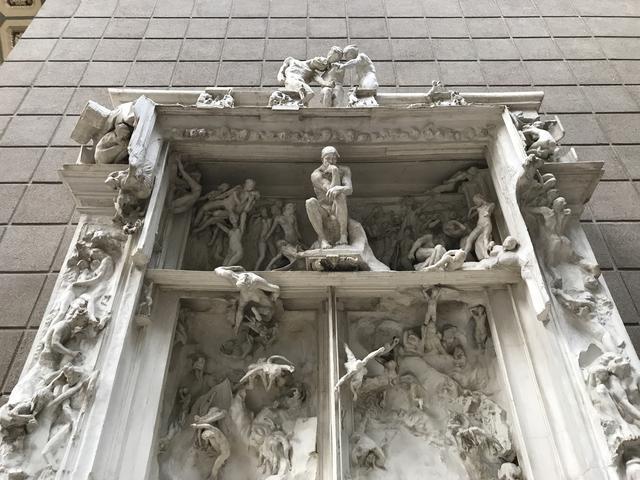The Gate of Hell

The Gate of Hell is a monumental sculptural group created by the renowned French artist Auguste Rodin, in collaboration with the talented sculptor Camille Claudel, over a span of nearly four decades from 1880 to 1917. This masterpiece is a true marvel of art, consisting of over two hundred intricately crafted figures and groups that are inspired by various literary works, including Dante Alighieri's Divine Comedy, Charles Baudelaire's The Flowers of Evil, and Franz Kafka's Metamorphosis. Rodin drew inspiration from his visit to Florence, particularly admiring the works of his favorite artist, Michelangelo, which greatly influenced the creation of The Gate of Hell.
The sculptural group was commissioned by Jules Ferry, with the original intention of being displayed at the Museum of Decorative Arts in Paris, which is now known as the Orsay Museum. The commission specified that Rodin would receive 8,000 francs for his work on this ambitious project. The Gate of Hell is a visual representation of Dante Alighieri's epic poem, depicting scenes of damnation and torment as described in the Divine Comedy. The influence of Baudelaire can be seen in the poses and expressions of the figures, particularly the women depicted in the portal.
As one gazes upon The Gate of Hell, they are transported into a world of anguish and despair, where the condemned souls are captured in various states of suffering and agony. The central figures of The Thinker, Paolo and Francesca, and Ugolino and his children stand out as poignant representations of human emotion and tragedy. The intricate details and expressive forms of the sculptures convey a sense of raw emotion and intensity, inviting viewers to contemplate the complexities of the human experience.
Rodin's meticulous attention to detail is evident in the three different models created during the sculpting process, each revealing a progression in the artist's vision and technique. The evolution of The Gate of Hell from its initial concept to the final bronze version showcases Rodin's dedication to his craft and his ability to capture the essence of profound literary works through the medium of sculpture. This iconic masterpiece continues to captivate audiences with its powerful imagery and timeless themes, solidifying Rodin's legacy as one of the greatest sculptors of all time.
© ChatGPT 3.5
When the work was commissioned, Rodin was forty years old, although he did not manage to see the casting of the work; after his death eight bronze castings were made. These versions are found in museums in the United States, Mexico, France, Japan, Switzerland and South Korea.
The only time Rodin showed Hell's Gate was during the 1900 Paris World's Fair in the Pavilion of the Soul.
Originally Roger Ballu was in charge of overseeing the entire process and in his reports he always praised Rodin's work.
From this door emerged the following sculptures that originally would have a place inside the Door: Ugolino, The Shadows, The Pain, The Kiss, The Thinker and The Danaide.
Camille Claudel, the sculptor with whom he made Hell's Gate, was also his student, lover and muse. Driving Camille even to the brink of madness.
The final version today is in the Musée d'Orsay in Paris in plaster form and dates from 1917. It is in the location for which it was commissioned, although not as a door.
It was in fact his personal life that made Rodin become a well-known figure. And so it was that many times his works acquired great recognition among investors. In the end there were so many orders that he needed to have several assistants to help him fulfill the orders that came to him. Another important detail is that Rodin did not sculpt, he was more of a modeler.